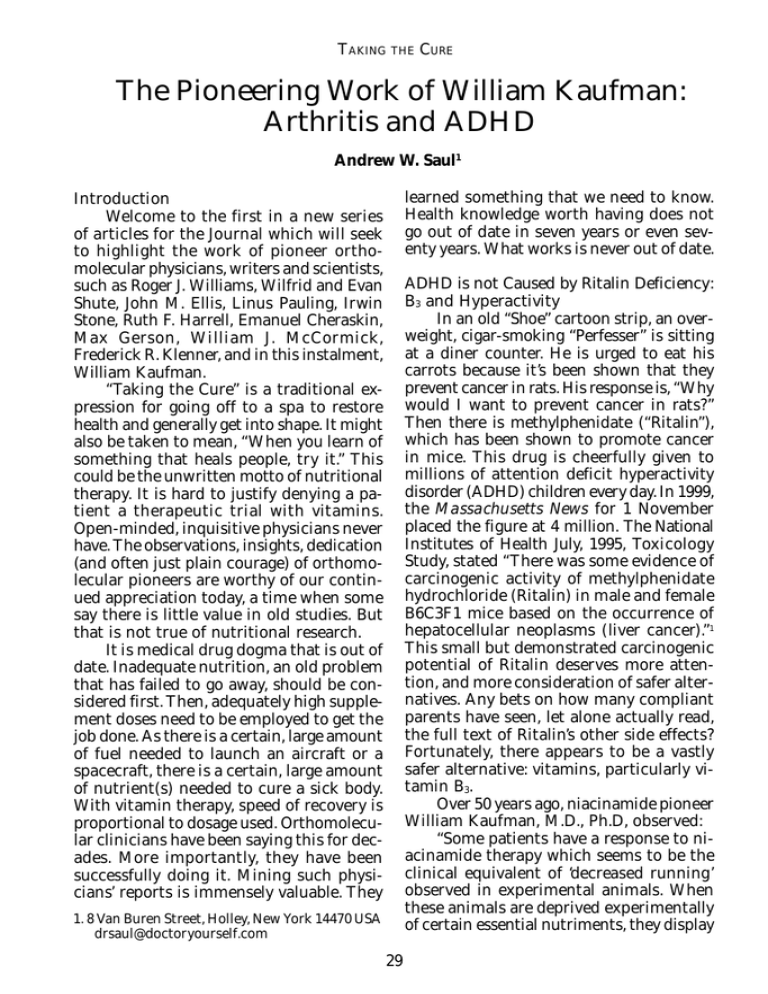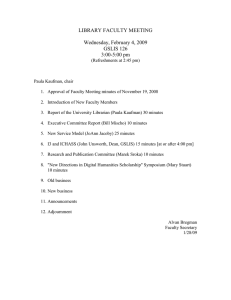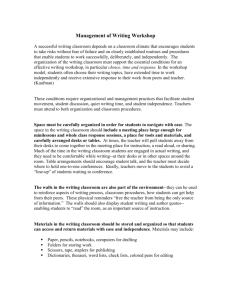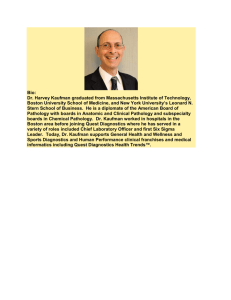The Pioneering Work of William Kaufman: Arthritis and ADHD
advertisement

TAKING THE CURE The Pioneering Work of William Kaufman: Arthritis and ADHD Andrew W. Saul1 learned something that we need to know. Health knowledge worth having does not go out of date in seven years or even seventy years. What works is never out of date. Introduction Welcome to the first in a new series of articles for the Journal which will seek to highlight the work of pioneer orthomolecular physicians, writers and scientists, such as Roger J. Williams, Wilfrid and Evan Shute, John M. Ellis, Linus Pauling, Irwin Stone, Ruth F. Harrell, Emanuel Cheraskin, Max Gerson, William J. McCormick, Frederick R. Klenner, and in this instalment, William Kaufman. “Taking the Cure” is a traditional expression for going off to a spa to restore health and generally get into shape. It might also be taken to mean, “When you learn of something that heals people, try it.” This could be the unwritten motto of nutritional therapy. It is hard to justify denying a patient a therapeutic trial with vitamins. Open-minded, inquisitive physicians never have. The observations, insights, dedication (and often just plain courage) of orthomolecular pioneers are worthy of our continued appreciation today, a time when some say there is little value in old studies. But that is not true of nutritional research. It is medical drug dogma that is out of date. Inadequate nutrition, an old problem that has failed to go away, should be considered first. Then, adequately high supplement doses need to be employed to get the job done. As there is a certain, large amount of fuel needed to launch an aircraft or a spacecraft, there is a certain, large amount of nutrient(s) needed to cure a sick body. With vitamin therapy, speed of recovery is proportional to dosage used. Orthomolecular clinicians have been saying this for decades. More importantly, they have been successfully doing it. Mining such physicians’ reports is immensely valuable. They ADHD is not Caused by Ritalin Deficiency: B3 and Hyperactivity In an old “Shoe” cartoon strip, an overweight, cigar-smoking “Perfesser” is sitting at a diner counter. He is urged to eat his carrots because it’s been shown that they prevent cancer in rats. His response is, “Why would I want to prevent cancer in rats?” Then there is methylphenidate (“Ritalin”), which has been shown to promote cancer in mice. This drug is cheerfully given to millions of attention deficit hyperactivity disorder (ADHD) children every day. In 1999, the Massachusetts News for 1 November placed the figure at 4 million. The National Institutes of Health July, 1995, Toxicology Study, stated “There was some evidence of carcinogenic activity of methylphenidate hydrochloride (Ritalin) in male and female B6C3F1 mice based on the occurrence of hepatocellular neoplasms (liver cancer).”1 This small but demonstrated carcinogenic potential of Ritalin deserves more attention, and more consideration of safer alternatives. Any bets on how many compliant parents have seen, let alone actually read, the full text of Ritalin’s other side effects? Fortunately, there appears to be a vastly safer alternative: vitamins, particularly vitamin B3. Over 50 years ago, niacinamide pioneer William Kaufman, M.D., Ph.D, observed: “Some patients have a response to niacinamide therapy which seems to be the clinical equivalent of ‘decreased running’ observed in experimental animals. When these animals are deprived experimentally of certain essential nutriments, they display 1. 8 Van Buren Street, Holley, New York 14470 USA drsaul@doctoryourself.com 29 Journal of Orthomolecular Medicine Vol. 18, No. 1, 2003 ‘excessive running,’ or hyperkinesis. When these deficient animals receive the essential nutriments in sufficient amounts for a sufficient period of time, there is exhibited a marked ‘decrease in running.’ ” “(A person) in this group may wonder whether or not his vitamin medications contain a sedative. He recalls that before vitamin therapy was instituted, he had a great deal of energy and ‘drive,’ and considered himself to be a ‘very dynamic person.’ Analysis of his history indicates that prior to niacinamide therapy he suffered from a type of compulsive impatience, starting many projects which he left unfinished as a new interest distracted him, returning perhaps after a lapse of time to complete the original project. Without realizing it, he was often careless and inefficient in his work, but was ‘busy all the time.’ ” This report appeared, almost as a side note, on page 73 of Kaufman’s 1949 book, The Common Form of Joint Dysfunction. So accurately does it describe the problems of ADHD children that it is difficult to believe that vitamin B3 (which never causes cancer) has been so thoroughly ignored for so long. Kaufman continues: “With vitamin therapy, such a patient becomes unaccustomedly calm, working more efficiently, finishing what he starts, and he loses the feeling that he is constantly driving himself. He has leisure time that he does not know how to use. When he feels tired, he is able to rest, and does not feel impelled to carry on in spite of fatigue. If such a patient can be persuaded to continue with niacinamide therapy, in time he comes to enjoy a sense of well-being, realizing in retrospect that what he thought in the past was a superabundance of energy and vitality was in reality an abnormal ‘wound-up’ feeling, which was an expression of aniacinamidosis (niacin deficiency).” ( p. 74) Dr. Evan Shute began investigating the use of vitamin E for abruptic plancentae in 1936 and discovered it cured cardiovascular disease. Even before this, Max Gerson, M.D., was treating migraine headaches with vegetable juices and therein found an effective therapy for various forms of cancer. William Kaufman, treated arthritis patients with niacinamide and noticed that it was also an effective remedy for hyperactivity and lack of mental focus. These and other natural healthcare milestones highlight just how dissimilar orthomolecular medicine and drug medicine truly are. While conventional medical authority would promptly admit malnutrition as one cause of cancer, and certainly as a cause of heart disease, there is a profound reluctance to allow that optimum nutrition could be curative of either. With ADHD, orthodox medicine seems unwilling even to admit nutrient deficiency as a causal factor, let alone a curative one. Nutritional information that does make news generally stays far from the headlines, unless, of course, it is critical of vitamins. The most widely publicized vitamin therapy trials tend to be low-dose, worthless, negative, or all three. Mass media attention to a given nutritional research study appears to be inversely proportional to its curative value. Therefore, the public and not a few physicians remain unaware of the power of simple and safe natural methods due to contradictory, inadequate, or just plain biased media reporting. When the press touts the “dangers” of vitamin “megadoses” while simultaneously overlooking Ritalin’s carcinogenic potential, it strains at a gnat and swallows a camel. Whereas drug side effects fill the Physician’s Desk Reference to bursting, I think we could truly say that the chief side effect of vitamins is failure to take enough of them. Perhaps the very concept of “megadose” needs to be rethought, and re-presented to the public. The quantity of a nutritional supplement that cures an illness indicates the patient’s degree of deficiency. It is therefore not a megadose of the vitamin, but rather a megadeficiency of the nutrient that we are dealing with. A dry 30 Taking the Cure sponge holds more milk. Dr. Kaufman advocated relatively modest quantities of niacinamide (250 mg) per dose but stressed the importance of the frequency of those doses. With the water-soluble vitamins, at any given quantity, frequently divided doses are invariably more effective. Niacinamide and Arthritis The authors of a 1996 study on niacinamide and osteoarthritis 2 could have omitted the words “pilot study” from their title. William Kaufman had already published, 47 years earlier, his meticulous case notes for hundreds of patients, along with specific niacinamide dosage information applicable to both osteoarthritis and rheumatoid arthritis. In addition, the doctor added some remarkably prescient observations on the antidepressant-antipsychotic properties of B3. Dr. Kaufman, whom his widow has described as a conservative physician, was nevertheless the first to prescribe as much as 5,000 mg niacinamide daily, in many divided doses, to improve range of joint motion. Mrs. Kaufman sent me these previously unpublished comments written by her husband not long before his death in 2000. “The (more frequent) 250 mg dose of niacinamide is 40 to 50% more effective in the treatment of arthritis than the (less frequent) 500 mg. dose. In my 1955 paper (The use of vitamin therapy to reverse certain concomitants of aging. J Amer Geriatric Soc. 3:927-936) I noted that niacinamide (alone or combined with other vitamins) in a thousand patient-years of use has caused no adverse side effects. Please keep in mind niacinamide is a systemic therapeutic agent. It measurably improves joint mobility, muscle strength, decreases fatiguability. It increases maximal muscle working capacity, reduces or completely eliminates arthritic joint pain. Some joints are so injured by the arthritic process that no amount of niacinamide therapy will cause improvement in joint mobility, but it takes 31 three months of niacinamide therapy before you can conclude this, since some joints are slow to heal.” (January, 13, 1998) More Excerpts from his Book “Theoretically, optimal nutrition must be continuously available to bodily tissues to ensure the best possible structure and function of tissues. While we do not know what constitutes optimal nutrition, it has been demonstrated empirically that even persons eating a good or excellent diet according to present-day standards exhibit measurable impairment in ranges of joint movement which tends to be more severe with increasing age. It has also been demonstrated that when such persons supplement their good or excellent diets with adequate amounts of niacinamide, there is, in time, measurable improvement in ranges of joint movement, regardless of the patients’ ages. In general, the extent of recovery from joint dysfunction of any given degree of severity depends largely on the duration of adequate niacinamide therapy.” (p 24) “Whenever a patient taking the amounts of niacinamide prescribed by the physician, and eating a good or excellent diet, fails to make satisfactory improvement in his Joint Range Index, in the absence of excessive mechanical joint injury the niacinamide schedule must be revised upward to that level which permits satisfactory improvement. Failure of the patient to take niacinamide as directed will result in failure to improve at a satisfactory rate.” (p 25) The entire text of Dr. Kaufman’s The Common Form of Joint Dysfunction has been republished on the Internet for free online reading. (http://www.doctor yourself. com/ kaufman.html) Chapter 1 containing the passage about “decreased running” mentioned earlier, also presents Dr. Kaufman’s niacinamide treatment protocol. He also used ascorbic acid, thiamin, and riboflavin, all in large doses. As his rationale and measurement methods begin the chapter, some Journal of Orthomolecular Medicine Vol. 18, No. 1, 2003 readers may wish to scroll down directly to the section on dosage (“Methods of Treatment”) and read that first. The chapter closes with case histories and an insightful, practical discussion of patient management. Chapter 2, Four Complicating Syndromes Frequently Coexisting with Joint Dysfunction, discusses physical and psychological stresses, allergy, posture, obesity and other factors that may interact or interfere with niacinamide megavitamin therapy for arthritis. Chapter 3, Coordination of Treatment, is a brief summary of Dr. Kaufman’s practical recommendations for case management. Chapter 4, Analysis of Clinical Data for the Untreated and Treated Population, presents Dr. Kaufman’s meticulous records of patients treated with niacinamide. Chapter 5, Some Inferences Concerning Joint Dysfunction, shows Dr. Kaufman’s remarkable foresight half a century into the future of orthomolecular medicine. In this chapter, he describes how the lack of a single nutrient can cause diverse diseases; the need for a new way of looking at arthritis, and reviews his treatment and what level of success to expect. Arthritis and ADHD? There is a recurrent problem with vitamins being perceived as “too useful.” Frederick R. Klenner, M.D. found ascorbate to be an effective and nearly all-purpose antitoxin, antibiotic and antiviral. One vitamin curing polio, pneumonia, measles, strep, snakebite, and Rocky Mountain Spotted Fever? Layperson and professional alike certainly struggle with that, and more so with the nearly four dozen other diseases Klenner reported success with. How did he do it? The plain explanation may be as simple as this: the reason that one nutrient can cure so many different illnesses is because a deficiency of one nutrient can cause many different illnesses. This has led to something of a vitamin public relations problem. When pharma- ceuticals are versatile, they are called “broad spectrum” and “wonder drugs.” When vitamins are versatile, they are called “faddish” and “cures in search of a disease.” Such a double-standard needs to be exposed and opposed at every turn. A vitamin can act as a drug, but a drug can never act as a vitamin. ADHD is not due to Ritalin deficiency, nor is arthritis caused by a deficiency of aspirin. But these seemingly unrelated health problems (and many others) may indeed be largely due to a common nutritional deficiency. Treating accordingly was a good idea in 1949, and it is just as good today. In 2002, Dr. Kaufman’s papers were acquired by the University of Michigan, Special Collections Library, 7th Floor, Harlan Hatcher Graduate Library, Ann Arbor, Ml 48109. email: special.collections @umich.edu Tel: 734-764-9377. A bibliography of Dr. Kaufman’s work will be found at http://www.doctoryourself. com/biblio_ kaufman.html. References 1. NTIS# PB96-162615 (http://ntp-server. niehs. nih. gov) 2. Jonas WB, Rapoza CP, Blair WF. The effect of niacinamide in osteoarthritis: a pilot study. Inflammatory Research, 45: 330-334. Further Reading Kaufman, W. Niacinamide therapy for joint mobility. Conn. State Med. J. 17:584-589, 1953 Kaufman, W. Niacinamide, a most neglected vitamin. 1978 Tom Spies Memorial Lecture. J. Int. Acad. of Preventive Med. 8:5-25,1983 Kaufman, W. Niacinamide improves mobility in degenerative joint disease. Abstract published in Program of the American Association for the Advancement of Science for its meeting in Philadelphia, May 24-30, 1986 32



